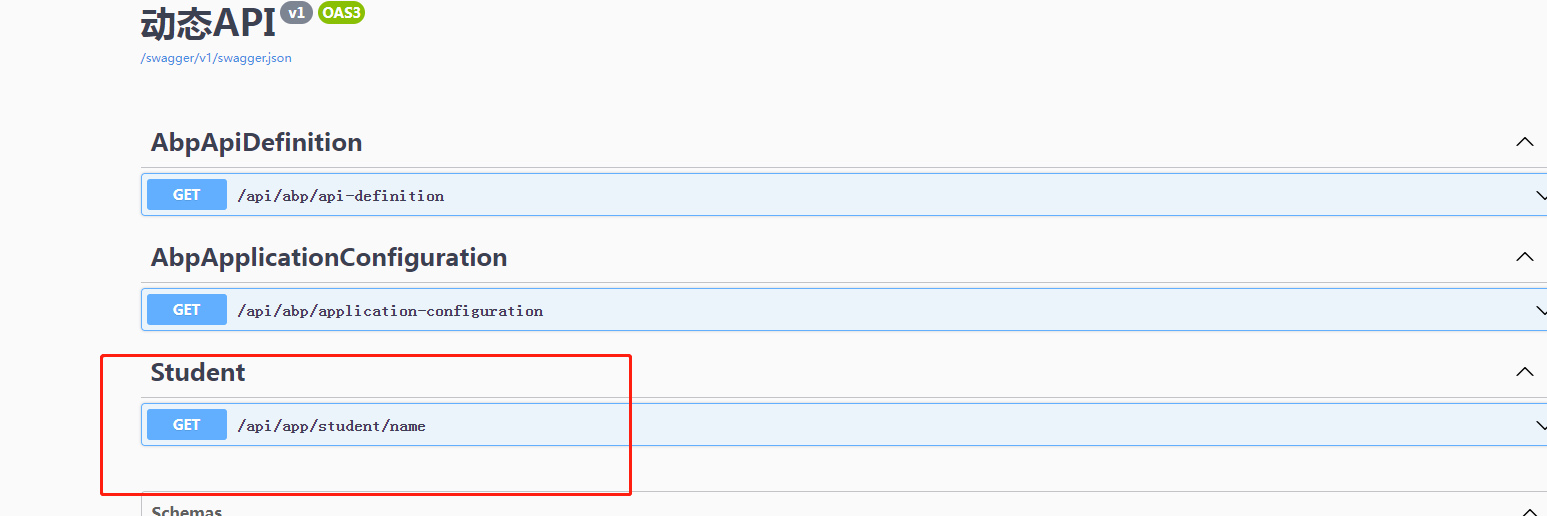ABP-VNEXT 学习笔记(四)自动API 控制器
官方文档地址:https://docs.abp.io/en/abp/latest/API/Auto-API-Controllers
详细的请阅读官方文档,这边侧重简化说明怎么应用和一些注意要点。
自动API,即代码端只需要定义服务层即可,无需每一个服务层方法都对应在控制器中编写一个action。
这个可以大大节省我们的时间和省略大量控制器端的代码。
该示例项目,我们建了一个ApplicationContract 接口层,一个Application 服务层,两个web项目。

接口层如下:
我们定义了2个接口,分别是获取姓名和年龄。
using System; using System.Collections.Generic; using System.Text; using System.Threading.Tasks; using Volo.Abp.Application.Services; namespace AbpAPI { public interface IStudentService:IApplicationService { Task<string> GetNameAsync(); Task<int> GetAgeAsync(); } }
服务层实现:
using Microsoft.AspNetCore.Http; using System; using System.Collections.Generic; using System.Linq; using System.Text; using System.Threading.Tasks; using Volo.Abp; using Volo.Abp.Application.Services; namespace AbpAPI { public class StudentService : ApplicationService, IStudentService { [RemoteService(IsEnabled =false)] //该设置表示该方法不自动生成api,但不影响直接调用。 public async Task<int> GetAgeAsync() { return await Task.FromResult(18); } public async Task<string> GetNameAsync() { return await Task.FromResult("李四"); } } }
下面是web层的注入:
using Microsoft.OpenApi.Models; using Volo.Abp; using Volo.Abp.AspNetCore.Mvc; using Volo.Abp.Autofac; using Volo.Abp.Modularity; using Volo.Abp.Swashbuckle; namespace AbpAPI.Web { [DependsOn(typeof(AbpAPIApplicationModule))] [DependsOn(typeof(AbpAspNetCoreMvcModule))] [DependsOn(typeof(AbpSwashbuckleModule))] [DependsOn(typeof(AbpAutofacModule))] public class AbpAPIWebModule : AbpModule { public override void ConfigureServices(ServiceConfigurationContext context) { base.ConfigureServices(context); //注入自动API Configure<AbpAspNetCoreMvcOptions>(options => { options .ConventionalControllers .Create(typeof(AbpAPIApplicationModule).Assembly); //设置哪个类库要自动API,可配置多个服务实现层 }); //下面是自动生成swaggerUI var services = context.Services; services.AddAbpSwaggerGen(options => { options.SwaggerDoc("v1", new OpenApiInfo { Title = "动态API", Version = "v1" }); options.DocInclusionPredicate((docName, description) => true); options.CustomSchemaIds(type => type.FullName); } ); } public override void OnApplicationInitialization(ApplicationInitializationContext context) { var app = context.GetApplicationBuilder(); //应用swaggerUI app.UseSwagger(); app.UseAbpSwaggerUI(options => { options.SwaggerEndpoint("/swagger/v1/swagger.json", "动态API"); }); base.OnApplicationInitialization(context); } } }
这里面做了2个配置
若单单配置自动API,只需要
//注入自动API Configure<AbpAspNetCoreMvcOptions>(options => { options .ConventionalControllers .Create(typeof(AbpAPIApplicationModule).Assembly); //设置哪个类库要自动API,可配置多个服务实现层 });
配置swaggerUI是方便我们查看api内容和模拟请求。
这样,就完成了自动API的配置。
有个点需要注意看官方文档的, 就是关于请求方式和url路径。官方文档做了详细说明。在路径默认固定以 /api/app/开头,方法名中的Get和async,service都会被清掉。
比如StudentService下的GetName方法,最终请求的url是 /api/app/student/name
下面我们运行起来,看swagger

可以看到,这时候只有getname方法是有生成API,GetAge是没有的。
至此,自动生成API的应用就这么简单。
更多分享,请大家关注我的个人公众号:





